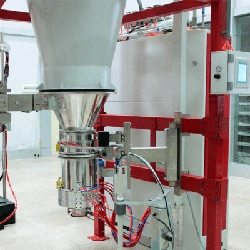Content Menu
● Understanding Swinger Reciprocators
>> What is a Swinger Reciprocator?
>> Key Features of Swinger Reciprocators
● The Role of Robotics in Coating Applications
>> What are Industrial Robots?
>> Advantages of Using Robots for Coating
● The Synergy Between Swinger Reciprocators and Robots
>> How They Work Together
>> Case Studies of Successful Integration
● Future Trends in Coating Technology
>> Smart Controls and IoT Integration
>> Advancements in Coating Materials
● Conclusion
>> Frequently Asked Questions
In the modern manufacturing landscape, the quest for efficiency and precision has led to the integration of advanced technologies in coating processes. Among these technologies, swinger reciprocators and robotic systems have emerged as pivotal components in achieving seamless coating applications. This article delves into how these two systems work together, enhancing productivity, consistency, and quality in various industrial applications.

Understanding Swinger Reciprocators
What is a Swinger Reciprocator?
A swinger reciprocator is an automated device designed to move coating guns back and forth over a workpiece. This motion ensures that the coating is applied uniformly across the surface, which is crucial for achieving high-quality finishes. The design of these reciprocators allows them to cover large areas efficiently, making them ideal for high-volume production environments.
Key Features of Swinger Reciprocators
- Automated Movement: Swinger reciprocators automate the back-and-forth motion of spray guns, reducing the need for manual labor and increasing efficiency.
- Adjustable Speed and Stroke Length: Operators can customize the speed and stroke length of the reciprocator to suit different coating applications, ensuring optimal coverage.
- Integration with Other Systems: These devices can be integrated with various coating technologies, including electrostatic and air spray systems, to enhance performance.
The Role of Robotics in Coating Applications
What are Industrial Robots?
Industrial robots are programmable machines capable of performing a variety of tasks, including painting, welding, and assembly. In the context of coating, robots are used to apply coatings with high precision and consistency, often in environments that require complex movements.
Advantages of Using Robots for Coating
- Precision and Consistency: Robots can apply coatings with a level of accuracy that is difficult to achieve manually. This precision reduces the likelihood of defects and ensures uniform thickness across surfaces.
- Flexibility: Modern robotic systems can be programmed to handle different shapes and sizes of workpieces, making them versatile for various applications.
- Reduced Labor Costs: By automating the coating process, companies can significantly reduce labor costs and minimize human error.
The Synergy Between Swinger Reciprocators and Robots
How They Work Together
The combination of swinger reciprocators and robotic systems creates a powerful solution for seamless coating applications. The reciprocator provides the necessary back-and-forth motion, while the robot can adjust its position and angle to ensure optimal coverage. This collaboration allows for:
- Enhanced Coverage: The reciprocator can cover large areas quickly, while the robot can focus on intricate details, ensuring that every part of the workpiece receives the appropriate coating.
- Improved Efficiency: By working in tandem, these systems can operate continuously, reducing downtime and increasing overall productivity.
- Quality Control: The integration of sensors and advanced control systems allows for real-time monitoring of the coating process, ensuring that any deviations from the desired application are corrected immediately.
Case Studies of Successful Integration
1. Automotive Industry: In automotive manufacturing, the combination of swinger reciprocators and robots has revolutionized the painting process. Robots apply the base coat while reciprocators handle the clear coat, ensuring a flawless finish.
2. Aerospace Applications: Aerospace components often require precise coatings to meet stringent safety standards. The synergy between these technologies allows for consistent application, reducing the risk of defects that could compromise safety.
3. Furniture Manufacturing: In the furniture industry, the use of these systems has streamlined the coating process, allowing for faster production times without sacrificing quality.
Future Trends in Coating Technology
Smart Controls and IoT Integration
The future of coating technology lies in the integration of smart controls and the Internet of Things (IoT). By connecting swinger reciprocators and robots to a centralized control system, manufacturers can achieve:
- Data-Driven Insights: Real-time data collection allows for better decision-making and process optimization.
- Predictive Maintenance: IoT-enabled systems can predict when maintenance is needed, reducing downtime and extending the lifespan of equipment.
Advancements in Coating Materials
As coating materials evolve, the need for precise application methods becomes even more critical. Innovations in materials, such as eco-friendly coatings and advanced polymers, will require the adaptability of both swinger reciprocators and robotic systems to ensure optimal performance.
Conclusion
The collaboration between swinger reciprocators and robotic systems represents a significant advancement in the field of industrial coatings. By leveraging the strengths of both technologies, manufacturers can achieve seamless coating applications that meet the demands of modern production environments. As technology continues to evolve, the integration of these systems will play a crucial role in enhancing efficiency, quality, and sustainability in coating processes.

Frequently Asked Questions
1. What are the main benefits of using swinger reciprocators in coating applications?
- Swinger reciprocators provide automated movement, adjustable speed, and the ability to integrate with various coating technologies, enhancing efficiency and consistency.
2. How do robots improve the coating process?
- Robots offer precision, flexibility, and reduced labor costs, allowing for consistent application and the ability to handle complex shapes.
3. Can swinger reciprocators and robots work together in all coating applications?
- While they are highly effective in many applications, the specific requirements of the coating process will determine the best configuration.
4. What industries benefit most from this technology?
- Industries such as automotive, aerospace, and furniture manufacturing have seen significant improvements in coating quality and efficiency through the use of these technologies.
5. What future trends should we expect in coating technology?
- Future trends include the integration of smart controls, IoT technology, and advancements in coating materials, which will enhance the capabilities of both swinger reciprocators and robotic systems.
Hot Tags: China, Global, OEM, private label, manufacturers, factory, suppliers, manufacturing company










































 .
. 